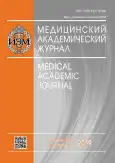Влияние глутамата на миграцию Т-клеток здоровых доноров и больных рассеянным склерозом в модели in vitro
- Авторы: Максимова МА1, Кузьмина УШ1, Бахтиярова КЗ2, Вахитова ЮВ1
-
Учреждения:
- ФГБУН «Институт биохимии и генетики» Уфимского научного центра РАН
- ФГБОУ ВО «Башкирский государственный медицинский университет» Минздрава РФ
- Выпуск: Том 19, № 1S (2019)
- Страницы: 29-30
- Раздел: Статьи
- Статья опубликована: 15.12.2019
- URL: https://journals.eco-vector.com/MAJ/article/view/19309
- ID: 19309
Цитировать
Полный текст
Аннотация
Цель исследования. Изучить хемотактические свойства глутамата и агонистов его рецепторов на миграцию Т-клеток здоровых доноров и больных рассеянным склерозом (РС) в модели in vitro. Материалы и методы. Миграцию Т-клеток 15 больных РС и 15 здоровых доноров изучали в модели in vitro с использованием трансвеллов. Лимфоциты активировали с РМА (10 нг/мл). Т-клетки добавляли в трансвеллы, мембрана которых обработана фибронектином (10 мкг/мл). В нижней камере содержались глутамат, AMPA или NMDA (100 мкМ для каждого) в полной среде RPMI. Мигрировавшие клетки собирали, окрашивали антителами к СD3-маркеру для последующего анализа методом цитофлуориметрии. Результаты и заключение. На фоне глутамата наблюдается тенденция к снижению миграционной активности в обеих группах доноров. В градиенте концентраций NMDA наблюдается снижение хемотаксиса Т-клеток здоровых доноров, но не больных РС. Активация лимфоцитов с РМА приводит к снижению количества мигрировавших клеток в среднем на 17 % (p < 0.01). У больных РС наблюдается тенденция к повышению хемотаксиса активированных клеток в градиенте глутамата, а под действием AMPA - к снижению. Таким образом, глутамат и агонисты его рецепторов не обладают выраженными хемотактическими свойствами но, вероятно, усиливают миграцию Т-клеток посредством синтеза молекул адгезии на поверхности лимфоцитов и эндотелия.
Ключевые слова
Полный текст
Об авторах
М А Максимова
ФГБУН «Институт биохимии и генетики» Уфимского научного центра РАН
У Ш Кузьмина
ФГБУН «Институт биохимии и генетики» Уфимского научного центра РАН
К З Бахтиярова
ФГБОУ ВО «Башкирский государственный медицинский университет» Минздрава РФ
Ю В Вахитова
ФГБУН «Институт биохимии и генетики» Уфимского научного центра РАН
Список литературы
- Levite M. Glutamate, T cells and multiple sclerosis. J. Neural Transm. (Vienna). 2017;124:775-798.
Дополнительные файлы







